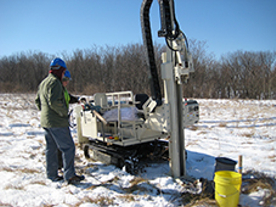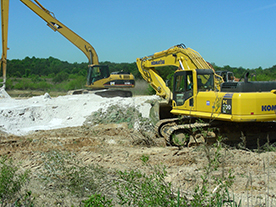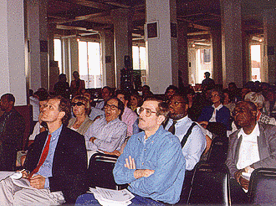
The CHS Enforcement Division oversees assessment and cleanup of hazardous waste sites by responsible persons. It also conducts assessment and cleanup of hazardous waste sites when no responsible person exists for a site or when the person is unable or unwilling to do the work. The statutory and regulatory requirements for carrying out the Hazardous Substances Response Plan are found in Section 7-222 of the Environment Article and in COMAR 26.14.
The Hazardous Substances Response Plan establishes the framework for conducting assessment and cleanup activities. The required work is broken into three phases: Assessment; Cleanup; and Operation and Monitoring.
Assessment Phase
 First, the Division requires that a detailed work plan be submitted for review and approval. This work plan provides a detailed schedule for performing a comprehensive investigation to study and assess the extent of contamination of soils and groundwater on and off the Site. Such plans must thorough enough to provide all parties with a Conceptual Site Model that supports the development of a Feasibility Study for different remedial alternatives.
First, the Division requires that a detailed work plan be submitted for review and approval. This work plan provides a detailed schedule for performing a comprehensive investigation to study and assess the extent of contamination of soils and groundwater on and off the Site. Such plans must thorough enough to provide all parties with a Conceptual Site Model that supports the development of a Feasibility Study for different remedial alternatives.
Site Assessment Components
- Characterize and describe the Site's physical features, geology and hydrogeology;
- Identify the contaminants present in the soil, groundwater and indoor air both on and off the Site;
- Determine waste characteristics (quantity, toxicity, persistence, propensity to bioaccumulate, and mobility);
- Describe the full horizontal and vertical extent of the plume(s) originating from the Site;
- Determine the the horizontal and vertical direction, as well as the velocity and direction of contaminant movement in groundwater;
- Evaluate factors influencing the plume movement and extrapolate the future contaminant movement;
- Description of the full vertical and horizontal extent of the soil contamination;
- Identify the specific contaminant concentrations;
- Identify the environmental pathways and exposure routes, including an evaluation of confining layers protecting community supply wells;
- Use EPA risk assessment guidance for the Superfund Program to identify the nature and threat posed by CHS; and
- Document the procedures used to characterize contaminant plume(s).
Cleanup Phase
 The cleanup phase of the Hazardous Substances Response Plan requires that a written evaluation of remedial alternatives including a time schedule for implementing each remedial alternative is reviewed and approved by the Division. The report containing the analysis of the remedial alternatives is called the Feasibility Study (FS). Each remedial alternative that is considered in the plan must describe the plans and specifications for proposed alternative remedial measures. The description must identify the equipment and systems to be used to control, contain, remove, treat and/or otherwise effectively remediate contaminated soils and groundwater both on and off the Site.
The cleanup phase of the Hazardous Substances Response Plan requires that a written evaluation of remedial alternatives including a time schedule for implementing each remedial alternative is reviewed and approved by the Division. The report containing the analysis of the remedial alternatives is called the Feasibility Study (FS). Each remedial alternative that is considered in the plan must describe the plans and specifications for proposed alternative remedial measures. The description must identify the equipment and systems to be used to control, contain, remove, treat and/or otherwise effectively remediate contaminated soils and groundwater both on and off the Site.
In addition, the FS must include the following information for each remedial alternative considered:
- Compliance with applicable cleanup standards and State or federal laws, regulations and other requirements;
- Short-term effectiveness;
- Long-term effectiveness and permanence;
- Reduction of toxicity, mobility, or volume through treatment;
- Implementability; and
- Costs, as follows:
- Capital costs, including both direct and indirect costs;
- Annual operating and maintenance costs; and
- Net present value of capital and annual operating and maintenance costs.
Once the Division has received the report, it evaluates the remedial alternatives submitted and then selects the remedy that is determined to be the most appropriate solution.

Operation, Maintenance and Monitoring Phase
After the Division has selected the remedy, the next step is to complete the design and implementation of the remedial action. If the work is being performed by a Responsible Person, the Division provides oversight, monitoring and enforcement to make sure that it is properly implemented. The Department may issue enforcement orders to ensure that the remedial action is properly implemented.
Departmental Action and Cost Recovery
In the event a party cannot or is unwilling to undertake a remedial action, the Division may remove or arrange for the removal of and provide for remedial action relating to the hazardous substances on the Site. It can seek reimbursement or sue for cost recovery under the provisions of Md. Code Envir. §§ 7-221 and 7-222(a)(2)(i).
Community Outreach and Public Participation

Public participation is also very important on hazardous substance site cleanup actions. For sites listed on the Disposal Site Registry where remedial actions are funded entirely by the Hazardous Substance Control Fund, the Department is required to publish the final selection of remedy in a major local newspaper of general circulation. It also may carryout the community relations and public information procedures described below. These procedures may include providing an opportunity for public informational meetings; receiving public comment on the proposed selection of remedy; and publishing a notice of informational meetings and proposed selections of remedy in a major local newspaper of general circulation.
In addition to other community relations and public information procedures, the Department shall, upon any county's request, provide information on sites of interest to the chief health or environment officer of the county, and an opportunity to consult with the Department before the Department's final selection of remedy. Finally, the Department may compile and maintain an administrative record that contains the documents that form the basis for the selection of a response action.
List of State Remediation Sites
The list of State Remediation Sites of current public interest can be found on this webpage. Additional sites may be found at the LRP Mapping site, and the LRP Factsheet webpage.
Technical Review Service
The Land Restoration Program’s Controlled Hazardous Substance Enforcement Division (Division) can provide technical reviews of environmental documents to interested parties. An interested party can obtain LRP’s technical assistance by submitting a written request and agree to cost recovery for the time spent on providing the technical assistance. The Division can review and comment on site-related documents as varied as environmental investigation and remediation reports, work plans, and/or proposed investigation/remediation strategies. Once it has completed its review, the Division provides the findings to the requester in a letter format, the content of which can range from a simple "No Further Action" determination to detailed comments, investigation/remediation requirements, and/or land use restriction requirements.
The technical review can be conducted prior to, or in conjunction with, a Voluntary Cleanup Program application. The Land Restoration Program encourages interested parties to discuss the business-specific requirements with in advance of any project.
Timing of Reviews
Conducting reviews of environmental documents ranges between two to four weeks. The timing of the review is dictated by the complexity of the assignment.
Cost Recovery for Performing Reviews
The Division bills the requester on a semi-annual schedule for its review time, at rates ranging from approximately $40 to $70 per hour. Generally, the cost of a straightforward TRS assignment is on the order of $500 to $1,000.
Scheduling a Project Review
Parties interested in scheduling an environmental project review can contact the Division at 410-537-3493 or by email at [email protected]. You will be asked to send the Division a formal letter requesting our TRS. The letter can be emailed to our attention and must include the nature of the review you are requesting, formal acknowledgement that the requester will be billed for this service, and the name and contact information for the person/entity that will be handling the Division's invoices. An example of a typical request letter is attached. Upon request, and for a fee, the Division can provide a technical review service (TRS) to interested parties. The Division can review and comment on site-related documents as varied as environmental investigation and remediation reports, work plans, and/or proposed investigation/remediation strategies. The Division provides the findings of its review to the requester in a letter format, the content of which can range from a simple "No Further Action" determination to detailed comments, investigation/remediation requirements, and/or land use restriction requirements.
Example Review Request Letter
Page composed with the free online HTML editor website. Please subscribe for a license to remove this message.